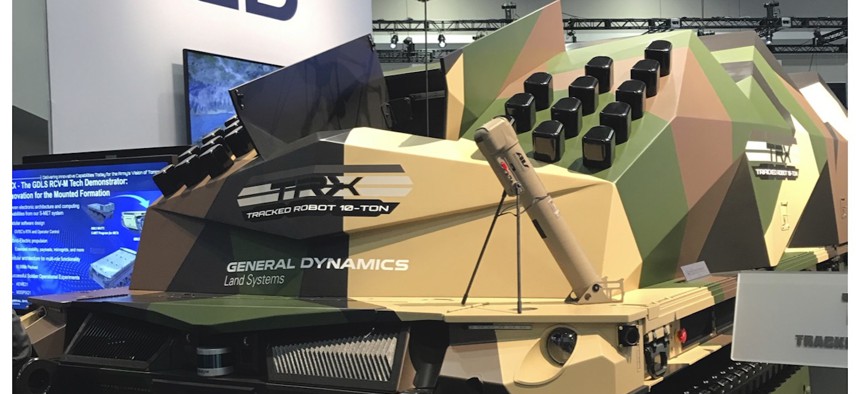
A prototype next-generation robotic combat vehicle from General Dynamics Land Systems, on display during the AUSA conference in Washington, D.C., October 12, 2021 Patrick Tucker / Defense One
US Army to Stage Largest Robot Tank Experiment Ever
Its lessons will inform the Army’s next-gen-unmanned-vehicles plan to ask tech firms to deliver the brains and established firms to deliver the wheels.
The U.S. Army intends to test an entire company of unmanned combat vehicles in simulated battle next year, a wargame that leaders called unprecedented and a big step toward refining the hardware and software that will one day enable wheeled robots to take the battlefield.
Gen. Ross Coffman, the director of Army Futures Command’s Next Generation Combat Cross-Functional Team, told reporters at AUSA this week that the closest thing to the Army’s upcoming robot exercise at Fort Hood, Texas, was last year’s platoon-sized effort at Fort Carson, Colorado.
For that exercise, the Army turned some old M113 armored personnel carriers into robots. “You can imagine that if you can turn a 113, you can turn anything into a robot,” Coffman said. “We learned a ton. There were some clear winners in the technology base. There were some that weren't as great.” Among the winners was the human-machine interface, he said.
“Now we're moving it up to company level.” he said. “The lessons learned here, we can now then apply to a brigade and to a division and see how we want to fight with these things in the future. But I know of no country that has done above singular vehicle experiments. So, no antecedent.”
Don't miss:
In August, the Army hired five firms to design prototypes for unmanned combat vehicles: Point Blank Enterprises., Oshkosh Defense, BAE Systems Land and Armaments, General Dynamics Land Systems, and American Rheinmetall Vehicles. Part of the deal: the vehicles must conform to an open systems architecture that can accomodate third-party software and sensors..
Program leaders hope that that will enable them to draw on the country’s top minds in vehicle autonomy, machine vision, and artificial intelligence. And there’s been an explosion in recent years of private sector and academic research in self-driving, autonomous and partially autonomous programming. But the best minds in autonomous driving aren’t necessarily the best equipped to make combat vehicles to military specification. So the Army has already developed what they call a robotic technology kernel: basically, a code base for future operating systems.They’ll use that to test autonomy software from different sources.
“Effectively, what that allows us to do is we can compete modules and reach best of breed from industry and academic or government agency partners, where we can compete at the behavior level and integrate those into an end item that gets integrated onto these systems. And so we've been exercising that process. We're on the verge now of selecting six vendors to continue to improve that autonomy software for competing behaviors,” said Michael Cadieux, director of ground vehicles for U.S. Army Development Command.
What are those behaviors? And how much autonomy in unmanned combat vehicles is the Army ultimately looking for? All of that depends on what AI solutions come out of tech firms and what the Army thinks is ultimately achievable. But the open systems architecture approach means that as new AI capabilities come out of labs the Army won’t have to do a lot of intensive software engineering to get them onto the vehicles.
“The government controls the interfaces, the standards and the way data is moved around the system. But we don't necessarily need to control the individual black boxes or the processors or the individual sensors. We just need to control the way that they communicate with one another. So we don't buy [intellectual property] that we don't need but that we have the ability to remove a modular component and replace it with a different one without re-architecting and redesigning the entire system,” Cadieux said.
That should allow the Army to ride the wave of better and better AI and autonomy products that will emerge out of Silicon Valley and academia over the coming years without relying on software that’s obsolete by the time it’s fielded.
The hardware and the software will come together virtually first, in a simulated environment to test how well everything works together before the Army commits to an expensive build, a similar approach to what the Army is now doing to prepare for its large connect-everything experiment later this fall.
“What we do first is we have a system integration lab that's a combination of both software virtual environments as well as the hardware that represents those systems. And we'll do it in a virtual world that will simulate it in a system integration lab and then apply it to the actual vehicle systems in a fairly relevant train to see how it performs. And that's the iterative approach that we've been taking,” said Cadieux.




